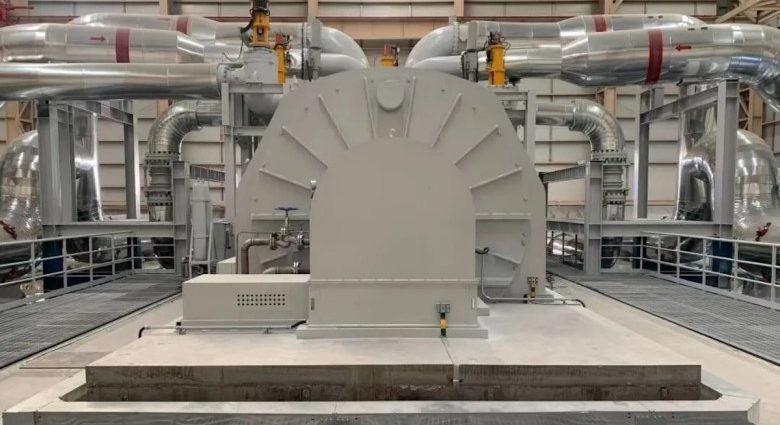For decades, global scientists have searched for low-cost methods to store excess electricity generated during non-peak hours for use during peak times. Yet both of the two most commonly used methods have serious limitations.
Batteries offer the highest energy efficiency – more than 90% – but they are expensive. Hydroelectric storage – storing kinetic energy by pumping water to a higher place – has an efficiency of 70-80% but the facility must be built next to a dam.
Now, China is expected to accelerate the development of its far less prevalent compressed air energy storage (CAES) projects to optimize its power grid performance and move in a greener direction.
The country’s first 100-MW CAES national demonstration project, which is touted as the largest and most efficient in the world, was connected to the national power grid in Zhangjiakou in Henan province on September 30.
Separately, the construction of the world’s largest salt cavern CAES facility, located in Tai’an in Shandong province, started on September 28 and is scheduled to commence operations in 2024.
Analysts believe China has significant potential to commercialize its CAES technology, which some have described as world-leading. At the same time, engineers note regulatory and technical hurdles remain are constraints on the sector’s growth.
In 1978, the world’s first CAES facility, the Huntorf Power Plant, was built in Lower Saxony, Germany. The pioneering plant uses excessive energy produced during non-peak hours to compress and cool air and then store it in an idle salt cavern.
During peak hours of energy consumption, the plant burns natural gas to heat up the compressed air, which then expands and pushes the turbines of power generators. The plant has an annual capacity of 290 MW with around 29% efficiency.
In 1991, the McIntosh Power Plant, a 110-MW CAES facility, began operations in the state of Alabama in the United States. It has an efficiency of about 54% and also operates with fossil fuel.
In China, at least nine CAES plants have commenced construction or operations with a total capacity of 682.5 MW. Most of them store compressed air in containers; only two stores the air in salt caverns, according to a recent research report by Tianfeng Securities.

Nineteen additional CAES projects, with a combined capacity of 5.38 GW, are in the planning stage, according to the report.
China’s CAES capacity will reach 6.76 GW in 2025 and 43.15 GW in 2030. Of all the types of energy storage in China, CAES will represent 10% by 2025 and then surge to 23% by 2030, if all goes to plan.
The China Industrial Association of Power Sources (CIAPS) said in an April report that China’s total energy storage capacity topped the world at 43.44 GW at the end of 2021.
Of that, 86.5% represented pumped hydroelectric storage, 11.8% battery storage and 1.3% thermal energy storage. Other methods, such as CAES and flywheel energy storage, represented 0.4%.
The new 100-MW energy storage facility in Zhangjiakou, developed by the Institute of Engineering Thermophysics (IET) of the Chinese Academy of Sciences, can generate more than 132 million kWh of electricity annually, providing electricity for up to 60,000 households during peak electricity consumption.
It can save 42,000 tons of standard coal and reduce carbon dioxide emissions by 109,000 tons annually, according to IET.
IET director Xu Yujie said: “The completion of the Zhangjiakou plant is an important milestone as the facility is a national demonstration project that can be a benchmark for other CAES projects in China.”
In China, most CAES plants claim to be “non-combustion” as they do not use fossil fuels to reheat the compressed air. CAES proponents say they have the technology to recycle the heat created during the air compression stage.
On July 26, China Energy Engineering Corp, a state-owned enterprise, announced the commencement of the construction of a 300-MW CAES plant in Yingcheng in Hubei province. It said the plant will be the world’s first “completely-green” 300-MW CAES plant and can generate about 500 million kWh of electricity per year.
On September 28, the company said it would invest 2.23 billion yuan (US$313 million) to build a 350-MW CAES facility in a salt cavern in Tai’an in Shandong province. Ultimately, the annual output of the plant is projected to reach 1 billion kWh.

Sun Siyang, a researcher at the Energy Research Institute of China Southern Power Grid, said non-combustion CAES has strong potential but developers must still tackle technical issues related to its centrifugal compressors.
Moreover, Sun said, most idle salt caverns can only be found in cities in the lower streams of the Yangtze River in Shandong and Guangdong, meaning other locations would have to pay extra to dig caverns or buy containers to build CAES plants.
He said private investors are still reluctant to invest in the sector as the central government has not yet revealed regulations for CAES power generation and its pricing.
Read: Solar panels a portrait of China supply chain risks
Follow Jeff Pao on Twitter at @jeffpao3

